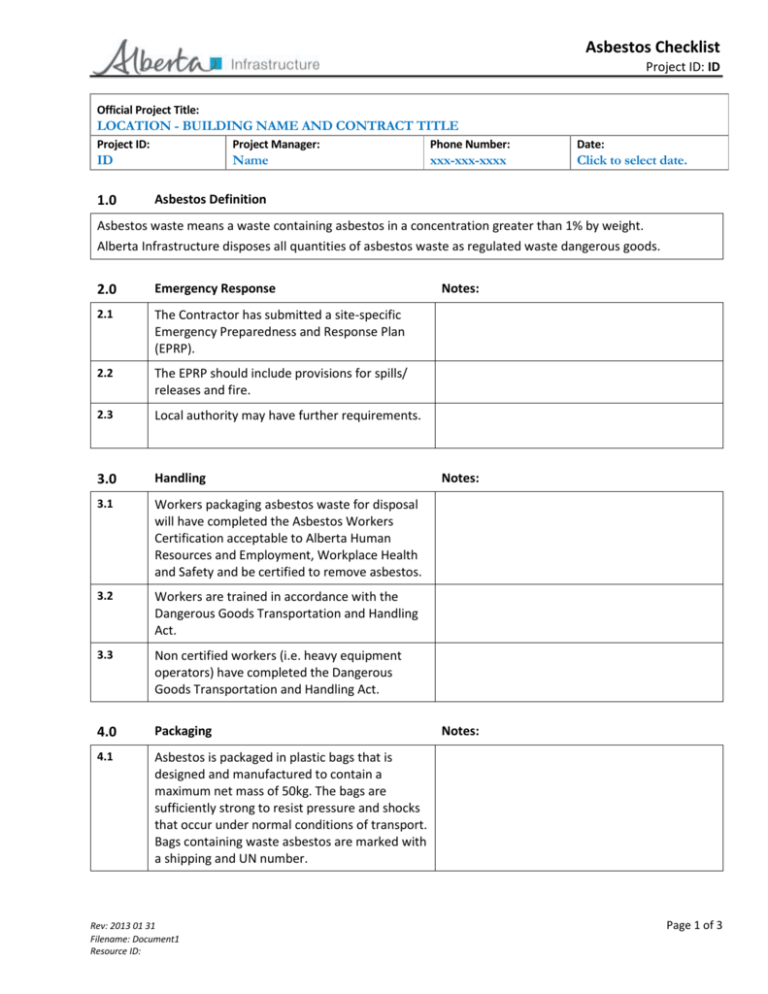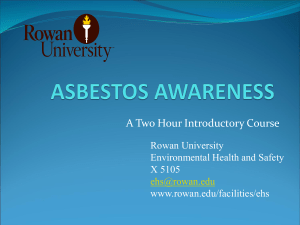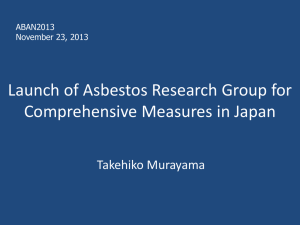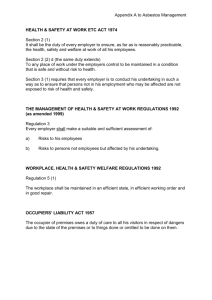EMS Asbestos Checklist template - Alberta Ministry of Infrastructure
advertisement

Asbestos Checklist Project ID: ID Official Project Title: LOCATION - BUILDING NAME AND CONTRACT TITLE Project ID: Project Manager: Phone Number: Date: ID Name xxx-xxx-xxxx Click to select date. 1.0 Asbestos Definition Asbestos waste means a waste containing asbestos in a concentration greater than 1% by weight. Alberta Infrastructure disposes all quantities of asbestos waste as regulated waste dangerous goods. 2.0 Emergency Response 2.1 The Contractor has submitted a site-specific Emergency Preparedness and Response Plan (EPRP). 2.2 The EPRP should include provisions for spills/ releases and fire. 2.3 Local authority may have further requirements. 3.0 Handling 3.1 Workers packaging asbestos waste for disposal will have completed the Asbestos Workers Certification acceptable to Alberta Human Resources and Employment, Workplace Health and Safety and be certified to remove asbestos. 3.2 Workers are trained in accordance with the Dangerous Goods Transportation and Handling Act. 3.3 Non certified workers (i.e. heavy equipment operators) have completed the Dangerous Goods Transportation and Handling Act. 4.0 Packaging 4.1 Asbestos is packaged in plastic bags that is designed and manufactured to contain a maximum net mass of 50kg. The bags are sufficiently strong to resist pressure and shocks that occur under normal conditions of transport. Bags containing waste asbestos are marked with a shipping and UN number. Rev: 2013 01 31 Filename: Document1 Resource ID: Notes: Notes: Notes: Page 1 of 3 Asbestos Checklist Project ID: ID 4.2 Asbestos waste is packaged in drums that are sturdy non-reusable, steel, aluminum or plastic, with tight fitting lids. Drums are appropriately labelled. 4.3 Bulky asbestos waste is packaged in two separate layers (150 micrometer thick), each layer sealed with water-resistant plastic duct tape. 4.4 The resulting package is constructed, filled and closed so that, under normal conditions of handling and transport, there will be no discharge, emission or escape of waste that could constitute a danger to public safety. 4.5 Asbestos is not mixed with other types of wastes. 4.6 Asbestos waste is secured and transported within an enclosed vehicle or covered by a tarpaulin or net when transported in a vehicle that is not enclosed. 5.0 Temporary Waste Storage 5.1 Signage is posted in asbestos storage areas. Storage areas are secure and only accessible to authorized personnel. 6.0 Transportation 6.1 Any persons transporting or handling dangerous goods has a TDG certificate. 6.2 Contractor transporting hazardous waste has correct TDG placarding on vehicles. 6.3 Contractor responsible to provide required manifests. Project Manager to provide generator number. 6.4 Friable asbestos waste is only transported in vehicles equipped with emergency spill clean-up equipment that includes a shovel, a broom, wetting agent, protective clothing, polyethylene bags, bag closures and respiratory equipment. Rev: 2013 01 31 Filename: Document1 Resource ID: Notes: Notes: Page 2 of 3 Asbestos Checklist Project ID: ID 7.0 Disposal 7.1 Asbestos has been disposed of by a licensed waste disposal facility (to be verified by copy of manifest). 7.2 Asbestos waste is sent to a landfill approved by the local Board of Health or a Class I or II industrial landfill. 8.0 Records 8.1 Records of all inspections conducted on site. 8.2 Copy of Shipping documents and manifests for transportation of waste. 8.3 Records of individuals who are fit tested and issued with respiratory equipment. 8.4 Copy of EPRP. 9.0 Reportable limits 9.1 An immediate report of incident to the local police is completed if a spill, emission or discharge of asbestos waste is in excess of 50kg (during transportation). 9.2 As asbestos waste is classified as class 9, a spill or release, from the transport, exceeding 25 kg is reportable to Alberta Transportation and the local police. Rev: 2013 01 31 Filename: Document1 Resource ID: Notes: Notes: Notes: Page 3 of 3








